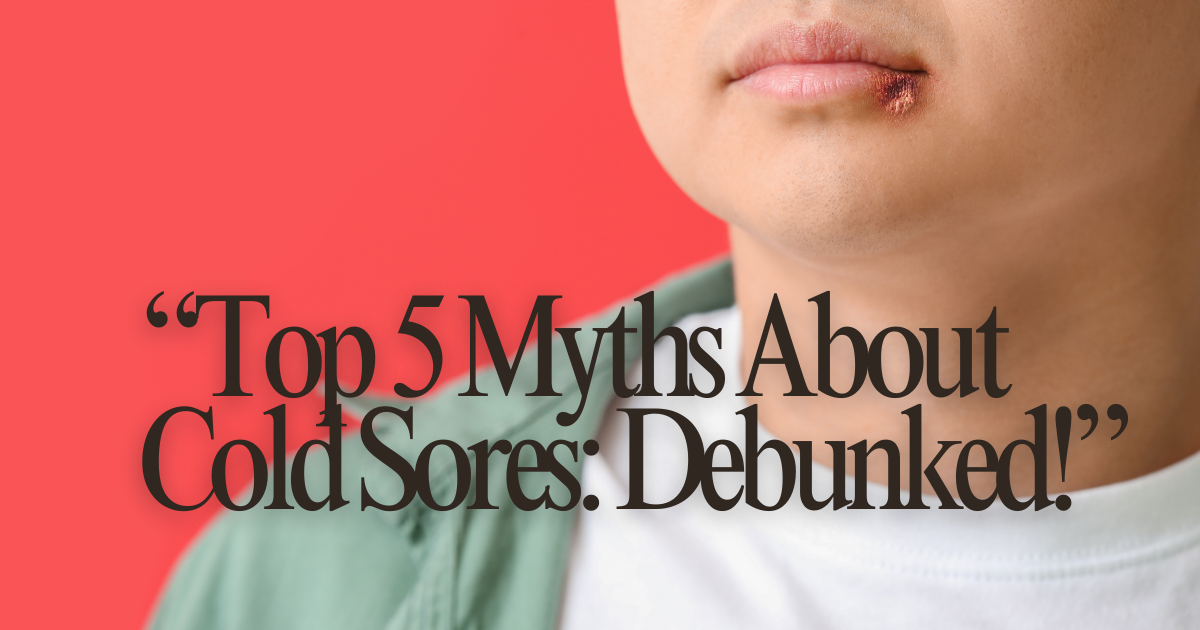
Cold sores are a common yet often misunderstood condition. Despite affecting millions of people worldwide, myths and misconceptions about cold sores persist, leading to confusion and improper treatment. Herein, we will be trying to debunk some of the most popular myths regarding cold sores with the aim to equip you with essential facts that would help you control this illness efficiently.
Myth 1: Cold Sores Are the Same as Canker Sores
Fact: Cold sores and canker sores are not the same. Cold sores, which are sometimes referred to as fever blisters, are produced by the herpes simplex virus (HSV-1). They usually manifest themselves as tiny vesicles filled with liquid on or around the lips and are extremely contagious. Canker sores, on the other hand, are non-transmissible ulcers that occur within the mouth and are not associated with a viral agent. The precise etiology of canker sores is still uncertain; however, they frequently occur as a result of stress, trauma or specific foods.
Understanding the difference between these two conditions is crucial for effective treatment and prevention.
Myth 2: Cold Sores Only Appear When You’re Sick
Fact: While illness can trigger a cold sore outbreak, it is not the only factor. Cold sores can be triggered by a variety of conditions, including stress, sun exposure, hormonal changes (such as those during menstruation), and even fatigue. The herpes simplex virus lies dormant in your body and can be reactivated by these triggers, leading to an outbreak. It’s important to recognize these triggers and take preventive measures.
Myth 3: Cold Sores Are Always Contagious
Fact: Cold sores are most contagious during the blistering and oozing stages. But they can also spread even when there are no visible blisters, especially by direct contact with the affected skin regions. Thus, it is important to be careful and not kiss or share utensils or lip products during an outbreak period. Although transmission risk is lower once the sore has dried up, one should still be careful until full recovery from a cold sore takes place.
Myth 4: There’s No Effective Treatment for Cold Sores
Fact: While there is no cure for the herpes simplex virus, effective treatments can manage and reduce the severity of cold sores, though their effectiveness can vary. For instance, valacyclovir (generic Valtrex) typically shortens a 6-day outbreak by about one day, while topical acyclovir (generic Zovirax) reduces a 5-day outbreak by about half a day. Docosanol (generic Abreva) has mixed results, with 25% of users healing within 2.5 days, compared to a 4.7-day median for those using a placebo.
If standard treatments don’t fully relieve symptoms, consider using pain relievers like Orajel or moisturizing products like Blistex. Patches, such as Mederma or Compeed, can also help with healing. A promising new treatment, NextLeap Cold Sore Care, features Tranexamic Acid, an enhanced form of lysine that can help restore the skin’s appearance within 1-2 days when applied at the first sign of a cold sore. Unlike other treatments, Tranexamic Acid does not cause sensitivity to sunlight, making it a safer option for many users for rapid cold sore care.
Myth 5: Once You Get a Cold Sore, You’re Stuck with It Forever
Fact: It’s true that once you are infected with the herpes simplex virus, it remains in your body for life. However, this doesn’t mean you’re doomed to suffer from constant outbreaks. Many people only experience cold sores occasionally, and with proper management and preventive strategies, the frequency and severity of outbreaks can be significantly reduced. Practicing good hygiene, avoiding known triggers, and taking antiviral medications as needed can help keep cold sores under control.
Understanding the truth about cold sores is essential for managing this condition effectively. By debunking these common myths, we hope to provide you with the knowledge you need to take control of your health and reduce the impact of cold sores on your life.
References
- National Institutes of Health (NIH) – “Herpes Simplex Virus”
- Available at: https://www.nih.gov
- Mayo Clinic – “Cold Sores: Causes, Symptoms, and Treatment”
- Available at: https://www.mayoclinic.org
- American Academy of Dermatology (AAD) – “Cold Sores: Who Gets and Causes”
- Available at: https://www.aad.org
- WebMD – “Understanding Cold Sores – The Basics”
- Available at: https://www.webmd.com
- Cleveland Clinic – “Cold Sores: Management and Prevention”
- Available at: https://my.clevelandclinic.org
